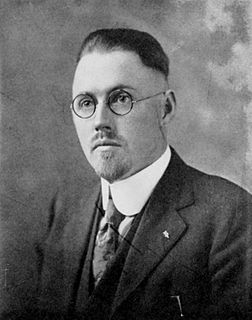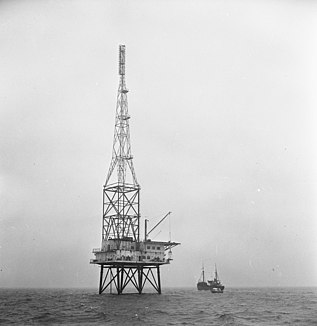This article relies largely or entirely on a single source .(March 2015) |
This article needs additional citations for verification .(March 2015) (Learn how and when to remove this template message) |
The Brinkley Act is the popular name given to 47 U.S.C. § 325(c) (originally section 325(b) of the Communications Act of 1934). This provision was enacted by the United States Congress to prohibit broadcasting studios in the U.S. from being connected by live telephone line or other means to a transmitter located in Mexico.
Title 47 of the United States Code defines the role and structure of the Federal Communications Commission, an independent agency of the United States government, and the National Telecommunications and Information Administration, part of the United States Department of Commerce. It also criminalizes damage by ships to underwater cables and defines how candidates for political office receive special access to broadcast stations. The Communications Act of 1934, the Communications Assistance for Law Enforcement Act, and the Launching Our Communities' Access to Local (LOCAL) Television Act of 2000 are codified in this title.

The Communications Act of 1934 is a United States federal law signed by President Franklin D. Roosevelt on June 19, 1934 and codified as Chapter 5 of Title 47 of the United States Code, 47 U.S.C. § 151 et seq. The Act replaced the Federal Radio Commission with the Federal Communications Commission (FCC). It also transferred regulation of interstate telephone services from the Interstate Commerce Commission to the FCC.

The United States Congress is the bicameral legislature of the Federal Government of the United States. The legislature consists of two chambers: the House of Representatives and the Senate.
Prior to World War II, Dr. John R. Brinkley controlled a high-power radio station, XERA, located in Ciudad Acuña, Coahuila (Acuna City), on the U.S.-Mexican border, across the Rio Grande from Del Rio, Texas. The programs on Brinkley's stations originated from studios in the US, which were connected to his transmitters via international telephone lines. Brinkley ran a popular but controversial program offering questionable medical advice to his listeners. Since Brinkley's transmitters were licensed in Mexico, which at the time had very limited regulation of broadcast content, his broadcasting licenses could not be directly threatened by the US government.

World War II, also known as the Second World War, was a global war that lasted from 1939 to 1945. The vast majority of the world's countries—including all the great powers—eventually formed two opposing military alliances: the Allies and the Axis. A state of total war emerged, directly involving more than 100 million people from over 30 countries. The major participants threw their entire economic, industrial, and scientific capabilities behind the war effort, blurring the distinction between civilian and military resources. World War II was the deadliest conflict in human history, marked by 50 to 85 million fatalities, most of whom were civilians in the Soviet Union and China. It included massacres, the genocide of the Holocaust, strategic bombing, premeditated death from starvation and disease, and the only use of nuclear weapons in war.

John Romulus Brinkley was an American who fraudulently claimed to be a medical doctor who became known as the "goat-gland doctor" after he achieved national fame, international notoriety and great wealth through the xenotransplantation of goat testicles into humans. Although initially Brinkley promoted this procedure as a means of curing male impotence, eventually he claimed that the technique was a virtual panacea for a wide range of male ailments. He operated clinics and hospitals in several states, and despite the fact that almost from the beginning, detractors and critics in the medical community thoroughly discredited his methods, he was able to continue his activities for almost two decades.

XERA is a radio station in Mexico, broadcasting on 760 AM in San Cristóbal de las Casas, Chiapas. The callsign was most famous for its use on a border blaster at Villa Acuña, Coahuila.
Dr. Brinkley's activities at his studio were thought to be a local matter, outside Congress's regulatory powers. However, the communications between the studio and his transmitters clearly involved international commerce and were therefore within Congress's power to regulate under the Commerce Clause. The operative language is as follows:
The Commerce Clause describes an enumerated power listed in the United States Constitution. The clause states that the United States Congress shall have power "To regulate Commerce with foreign Nations, and among the several States, and with the Indian Tribes." Courts and commentators have tended to discuss each of these three areas of commerce as a separate power granted to Congress. It is common to see the individual components of the Commerce Clause referred to under specific terms: the Foreign Commerce Clause, the Interstate Commerce Clause, and the Indian Commerce Clause.
- No person shall be permitted to locate, use, or maintain a radio broadcast studio or other place or apparatus from which or whereby sound waves are converted into electrical energy, or mechanical or physical reproduction of sound waves produced, and caused to be transmitted or delivered to a radio station in a foreign country for the purpose of being broadcast from any radio station there having a power output of sufficient intensity and/or being so located geographically that its emissions may be received consistently in the United States, without first obtaining a permit from the Commission upon proper application therefor.
The law goes on (47 U.S.C. § 325(d)) to state that the legal process for requesting such a permit is the same as that for requesting or renewing a license for a domestic station.
Although the original purpose of the Brinkley Act was to shut down a broadcaster, such applications are today granted as a matter of course, and a number of US broadcasters are permitted to program Mexican stations from their US studios in communities such as San Diego, California and Brownsville, Texas, where as many as a third of the stations in each radio market are licensed in Mexico. In recent years the law has returned to prominence, as its provisions have been used to extend US ownership limits to Mexican stations leased by US broadcasters.

San Diego is a city in the U.S. state of California. It is in San Diego County, on the coast of the Pacific Ocean in Southern California, approximately 120 miles (190 km) south of Los Angeles and immediately adjacent to the border with Mexico.

California is a state in the Pacific Region of the United States. With 39.6 million residents, California is the most populous U.S. state and the third-largest by area. The state capital is Sacramento. The Greater Los Angeles Area and the San Francisco Bay Area are the nation's second and fifth most populous urban regions, with 18.7 million and 8.8 million residents respectively. Los Angeles is California's most populous city, and the country's second most populous, after New York City. California also has the nation's most populous county, Los Angeles County, and its largest county by area, San Bernardino County. The City and County of San Francisco is both the country's second-most densely populated major city after New York City and the fifth-most densely populated county, behind only four of the five New York City boroughs.

Brownsville is a city in Cameron County in the U.S. state of Texas. It located on the western Gulf Coast in South Texas, adjacent to the border with Matamoros, Mexico. The city covers 81.528 square miles (211.157 km2) and has a population of 183,299 as of 2017. It is the 131st-largest city in the United States and 16th-largest in Texas. It is part of the Brownsville–Matamoros conurbation, with a population of 1,136,995 people. The city is known for its year-round subtropical climate, deep-water seaport and Hispanic culture.












